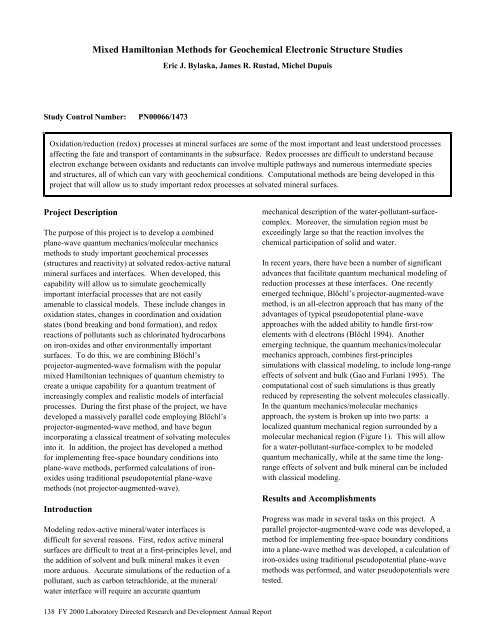PNNL-13501 - Pacific Northwest National Laboratory
PNNL-13501 - Pacific Northwest National Laboratory
PNNL-13501 - Pacific Northwest National Laboratory
Create successful ePaper yourself
Turn your PDF publications into a flip-book with our unique Google optimized e-Paper software.
Mixed Hamiltonian Methods for Geochemical Electronic Structure Studies<br />
Study Control Number: PN00066/1473<br />
Eric J. Bylaska, James R. Rustad, Michel Dupuis<br />
Oxidation/reduction (redox) processes at mineral surfaces are some of the most important and least understood processes<br />
affecting the fate and transport of contaminants in the subsurface. Redox processes are difficult to understand because<br />
electron exchange between oxidants and reductants can involve multiple pathways and numerous intermediate species<br />
and structures, all of which can vary with geochemical conditions. Computational methods are being developed in this<br />
project that will allow us to study important redox processes at solvated mineral surfaces.<br />
Project Description<br />
The purpose of this project is to develop a combined<br />
plane-wave quantum mechanics/molecular mechanics<br />
methods to study important geochemical processes<br />
(structures and reactivity) at solvated redox-active natural<br />
mineral surfaces and interfaces. When developed, this<br />
capability will allow us to simulate geochemically<br />
important interfacial processes that are not easily<br />
amenable to classical models. These include changes in<br />
oxidation states, changes in coordination and oxidation<br />
states (bond breaking and bond formation), and redox<br />
reactions of pollutants such as chlorinated hydrocarbons<br />
on iron-oxides and other environmentally important<br />
surfaces. To do this, we are combining Blöchl’s<br />
projector-augmented-wave formalism with the popular<br />
mixed Hamiltonian techniques of quantum chemistry to<br />
create a unique capability for a quantum treatment of<br />
increasingly complex and realistic models of interfacial<br />
processes. During the first phase of the project, we have<br />
developed a massively parallel code employing Blöchl’s<br />
projector-augmented-wave method, and have begun<br />
incorporating a classical treatment of solvating molecules<br />
into it. In addition, the project has developed a method<br />
for implementing free-space boundary conditions into<br />
plane-wave methods, performed calculations of ironoxides<br />
using traditional pseudopotential plane-wave<br />
methods (not projector-augmented-wave).<br />
Introduction<br />
Modeling redox-active mineral/water interfaces is<br />
difficult for several reasons. First, redox active mineral<br />
surfaces are difficult to treat at a first-principles level, and<br />
the addition of solvent and bulk mineral makes it even<br />
more arduous. Accurate simulations of the reduction of a<br />
pollutant, such as carbon tetrachloride, at the mineral/<br />
water interface will require an accurate quantum<br />
138 FY 2000 <strong>Laboratory</strong> Directed Research and Development Annual Report<br />
mechanical description of the water-pollutant-surfacecomplex.<br />
Moreover, the simulation region must be<br />
exceedingly large so that the reaction involves the<br />
chemical participation of solid and water.<br />
In recent years, there have been a number of significant<br />
advances that facilitate quantum mechanical modeling of<br />
reduction processes at these interfaces. One recently<br />
emerged technique, Blöchl’s projector-augmented-wave<br />
method, is an all-electron approach that has many of the<br />
advantages of typical pseudopotential plane-wave<br />
approaches with the added ability to handle first-row<br />
elements with d electrons (Blöchl 1994). Another<br />
emerging technique, the quantum mechanics/molecular<br />
mechanics approach, combines first-principles<br />
simulations with classical modeling, to include long-range<br />
effects of solvent and bulk (Gao and Furlani 1995). The<br />
computational cost of such simulations is thus greatly<br />
reduced by representing the solvent molecules classically.<br />
In the quantum mechanics/molecular mechanics<br />
approach, the system is broken up into two parts: a<br />
localized quantum mechanical region surrounded by a<br />
molecular mechanical region (Figure 1). This will allow<br />
for a water-pollutant-surface-complex to be modeled<br />
quantum mechanically, while at the same time the longrange<br />
effects of solvent and bulk mineral can be included<br />
with classical modeling.<br />
Results and Accomplishments<br />
Progress was made in several tasks on this project. A<br />
parallel projector-augmented-wave code was developed, a<br />
method for implementing free-space boundary conditions<br />
into a plane-wave method was developed, a calculation of<br />
iron-oxides using traditional pseudopotential plane-wave<br />
methods was performed, and water pseudopotentials were<br />
tested.

















